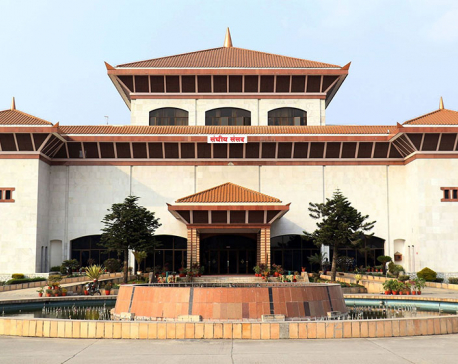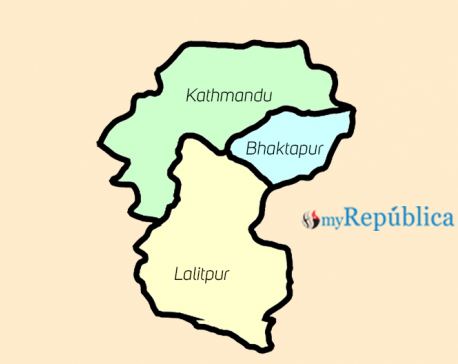
OR
Charting a course for better days
Published On: April 26, 2020 07:30 PM NPT By: George Varughese and Iain Payne
More from Author
The COVID-19 crisis has demonstrated the need for Nepal to reimagine its place in the world
The COVID-19 pandemic has triggered a global crisis that will continue for many months. It is already transforming social and economic life while altering the practice of politics and government. For Nepal, one of a relatively small group of countries that remains classified as a least developed country, the long-term impact of the crisis is likely to be exacerbated by perennial vulnerabilities and a legacy of poor policy choices regarding the national interest.
The first reaction to the COVID-19 pandemic in countries with less capable public health systems has been to deploy muscular lockdown measures and take stock of meager emergency supplies, personnel, and facilities. Amidst a fourth week of lockdown, there are clear signs that Nepal is no different in reaction and is struggling to cope during this crisis. Hurriedly grafted onto a public administration system that is hollowed out and weakened by a deeply entrenched kleptocratic network, Nepal’s emergency measures appear technically compromised from the start, vulnerable to unscrupulous opportunism, and lacking in strategic coherence or direction.
In the near and medium term, the expected policy choices for most developed countries are between lifesaving lockdown options and their economic and social trade-offs. Wealthier countries like Austria, Denmark, Germany, and Norway have already begun deploying step-by-step plans for reopening businesses and educational institutions. To be sure, these plans are premised on essential public trust in government’s ability to keep citizens safe while buffering economic downturns. Closer home, China and India are contrasting examples of policy choices that are having drastically different outcomes for their citizens. Even as Nepal’s immediate neighbors, these global economic powerhouses may not offer policy lessons that translate easily for a least developed country caught by the pandemic amidst the biggest governance transition in its modern history.
Getting serious about policy choices
Many lessons on pandemic response and recovery are available for adaptation to Nepal’s context. While it is indisputable that addressing the pandemic is the priority of all governments across the world, there may be the tendency for some governments to respond to the pandemic as if it were a one-off event like an earthquake or storm. Bio-induced crises are cyclical and everchanging; preparedness requires enormous investment and consistent focus that only wealthy countries can bring. Thus, in countries like Nepal, where myriad developmental needs clamor for policy attention and scarce resources, there is great temptation to react only for the immediate term. That would be a big mistake: as every recent crisis has revealed in stark relief, Nepal is extremely vulnerable to underlying threats that can quickly become existential for large segments of the population and potentially the entire country. For Nepal, response to crises must therefore be treated as a strategic opening to deliberately turn focus onto underlying threats, and appropriate and affordable policy choices, as well as previously intractable reform opportunities.
For one, crisis resilience must become a strategic policy priority of Nepali government and indeed political parties. At a fundamental level, this requires realistic assessments of the threats and vulnerabilities that Nepal actually faces, and thus conventional considerations of national security and development must be reconsidered. Nepal urgently needs to achieve food self-sufficiency and renewable energy security, rationalize emergency services and stockpiles across all seven provinces, counter terrorism, and better manage its borders. Resilience also requires strategic investment in technologies that support vertical and horizontal coordination of government, remote education and health, food supply chains, and energy efficiency.
Secondly, the need to dismantle Nepal’s kleptocratic network is vital for national security and development. The Omni Group procurement scandal clearly highlights how the country’s kleptocrats undermine the public good even during acute crisis. While communicating the true cost of corruption to the public is often difficult, the Omni scandal has done so quite easily in the context of a public health emergency, even putting the Prime Minister’s Office on the backfoot precisely at a time when there is urgent need to build public trust for government. Trust, irrespective of regime type, ‘is the single most important commodity that will determine the fate of a society’ as it resists COVID-19. Two years into a five-year term, the current federal government has added significantly to a trust deficit created by past governments. However, with its majority in both houses providing an added degree of political stability, now is the perfect moment to regaining public trust through compassionate, enlightened, and resolute leadership. To this end, prioritizing the elimination of corruption in the center of government is a critical policy choice. Two other strategic countercorruption entry points are reform of political and election campaign finance and the elimination of the use of the Nepal Army on non-security matters.
Thirdly, the crisis exposes critical gaps in Nepal’s policymaking processes, which must be plugged. These gaps begin from an unwieldy and bloated pre-federal public administration architecture that must be rationalized to drive policy coherence across the whole of government. With reduced implementation responsibilities in the federal scheme, government in Kathmandu needs to drastically shrink in size and adjust its scope to enable shared-rule and self-rule. Further, there are massive weaknesses in how data and evidence are utilized by government, which become glaring during times of crisis. For example, despite the announcement of COVID-19-related economic support for the poor, there is neither a standard definition nor a database to identify those who qualify to receive the assistance. The fragmented approach to data is not helpful, especially with new institutions and agencies of government under federalism. Improving and unifying data for whole-of-government use as the evidence for policy making is an essential policy choice. It is time to commit to prioritizing data-driven government by overhauling the Central Bureau of Statistics, adding a substantial policy assessment function, and elevating it to a National Bureau of Statistics & Assessment.
There is also a critical blindness towards informality in Nepali policymaking, which has been based on conventional notions of poverty and does not usefully capture the intersectionality of informality with vulnerability. For example, the continued failure to understand, treat, and engage the informal sector as the majority perpetuates the development of policy that does not engage fundamental governance concerns on inequality and justice. The COVID-19 crisis has abruptly illuminated the glaring disparities between Nepal’s ‘haves’ and ‘have nots’, most starkly between those in the formal versus informal sectors. As a day worker describing the lockdown put it: ‘Rich people have managed to store food and can now spend some time at home with their families. It’s like a vacation for them… But for working class people like us, if this situation prolongs, we will die of hunger.’ The pressing needs of society’s most vulnerable can be better understood and prioritized through an informality-based policy approach. Rather than compounding and entrenching patterns of rising inequality, the crisis should be seized as an opportunity by policymakers to shape a new, equitable social contract based on the evidence of informality.
Fourthly, the crisis provides a strategic opening to reimagine policy support for development effectiveness in a federalized context. In a country with limited state resources and challenging physiographies, past centralized and insular approaches to the delivery of fundamentally compatible public services have had limited effectiveness and have encouraged policy incoherence. Strategic choices must be made around inter-sectoral policy coherence. This is the case in health and education, for example, where the desired outcomes of citizen wellbeing and capability depend on the effective concurrent delivery of both health and education services. The resilience required during crises reinforces this need for strategic intersectoral coherence. With provincial and municipal governments already combining both health and education into one portfolio there is opportunity to test such coherence. Similarly, there is opportunity to make strategic choices on the architecture of service delivery in order to support development effectiveness. The erstwhile district architecture of the previous unitary state is neither fit for purpose nor constitutionally legitimate in most instances. In keeping with constitutional provisions to devolve power, it is time to consider subsuming districts into special jurisdictions that help provincial and municipal governments provision public goods and services more effectively.
Crucially for development effectiveness, it is important to rethink policy choices around development funding. It should not take the panic of crisis to be creative in funding modalities: these should be rationalized and linked to both government and to non-government entities based on ability, utility, and accountability. Centralized approaches to development planning have not been effective and, in fact, may be undermining creative exploration of other approaches that should use subsidiarity and resilience as guiding principles. Federalism provides an opportunity to incentivize provincial and municipal governments to raise and spend resources for development, based on ability, utility, and accountability. It also provides an opportunity to choose modalities that combine development planning with development financing, eliminating competition and politicization.
Finally, the crisis reveals continued challenges in effective representation of Nepali interests globally. The hapless Nepali migrants stranded around the world and the controversy surrounding the country’s diplomatic representatives are symptomatic of deeper problems of unaccountable process and of thin substance in policy choice. Effectiveness of representation is consistently undermined by the excessively political process of ambassadorial nomination, appointment, and recall. In addition to rationalizing a ceiling for political appointees and better utilizing Nepal’s foreign service professionals a foreign policy white paper must be produced. Instead of a scattershot foreign non-policy, the white paper must present Nepal’s self-interest rightly understood, using evidence to prioritize important relationships, provide criteria justifying diplomatic missions, and dispense with confusing language about ‘balancing interests’ or ‘maintaining equal distance’. While the coronavirus performance of the superpowers has been unimpressive, the crisis has thrust smaller countries—Singapore, Taiwan, South Korea, New Zealand, Iceland, and Ireland—into the global leadership spotlight. If anything, the crisis demonstrates the need for Nepal to reimagine its place in the world: it too should aspire to join the league of small, well-run countries.
At this time, the only thing that is increasingly clear is that many changes are being forced on governments and societies by the pandemic. For most countries, the contrast of old with new will be jarringly different and dispiriting, but probably only for a brief period because of their systemic resilience and relative prosperity. Pre-COVID tendencies may also continue in many countries. As a least developed country measuring poorly on capability and prosperity, the contrast may not be so stark for Nepal, which is extremely resilient for precisely those reasons. However, instead of continuing poor policy practice, this is the moment for Nepal to become agile and creative in adapting and responding to the changed patterns of international life, beginning with a self-critical appraisal of circumstances and seriousness in policy choices going forward. Only then can the challenge of pandemic become a unique opportunity to chart a course to better days ahead.
George Varughese and Iain Payne are associated with Niti Foundation
You May Like This

House panel directs CIAA to further investigate alleged corruption in medical equipment procurement for combating COVID-19
Minister Dhakal said that he is ready to face any action if he is found guilty of embezzling state funds... Read More...

AI-enabled platform is making online classrooms smart in Nepal and elsewhere
Fusemachines is offering a grant to help schools and colleges go online ... Read More...

Prohibitory order in Kathmandu Valley extended for one more week (with notice)
KATHMANDU, Sept 2: The district administration offices (DAOs) of the Kathmandu Valley have decided to extend ongoing prohibitory order for... Read More...




Just In
- Nepalgunj ICP handed over to Nepal, to come into operation from May 8
- Nepal to gift two elephants to Qatar during Emir's state visit
- NUP Chair Shrestha: Resham Chaudhary, convicted in Tikapur murder case, ineligible for party membership
- Dr Ram Kantha Makaju Shrestha: A visionary leader transforming healthcare in Nepal
- Let us present practical projects, not 'wish list': PM Dahal
- President Paudel requests Emir of Qatar to help secure release of Bipin Joshi held hostage by Hamas
- Emir of Qatar and President Paudel hold discussions at Sheetal Niwas
- Devi Khadka: The champion of sexual violence victims




_20240423174443.jpg)











Leave A Comment